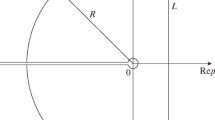Abstract
Two models for analyzing the process of extraction (and impregnation) from a porous material are considered. Cells, i.e., discrete space descriptions, are used in the models. The first model also assumes a discrete time description. In the second model, time varies continuously. It is shown that these two models and a conventional (diffusion) model form a hierarchical chain of models. Relationships for calculating the quantity of the target component in a porous solid are derived.
Similar content being viewed by others

References
Aksel’rud, G.A. and Lysyanskii, V.M., Ekstragirovanie. Sistema tverdoe telo -zhidkost’,(Extraction: Solid—Liquid System), Leningrad: Khimiya, 1974.
Aksel’rud, G.A. and Al’tshuler, M.A., Vvedenie v kapill-yarno-khimicheskuyu tekhnologiyu,(Introduction to Capillary Chemical Technology), Moscow: Khimiya, 1983.
Abiev, R.Sh., Study of the Process of Extraction from a Capillary-Porous Particle with a Bidispersed Structure, Zh. Prikl. Khim., 2000, vol. 74, no. 5, p. 754.
Abiev, R.Sh. and Ostrovskii, G.M., Modeling of the Process of Extraction from a Capillary-Porous Particle with a Bidispersed Structure, Teor. Osn. Khim. Tekhnol., 2001, vol. 35, no. 3, p. 270.
Malyshev, R.M., Kutepov, A.M., Zolotnikov, A.N., et al., Influence of Superimposition of the Field of Low-Frequency Oscillations on the Efficiency of Extraction and a Mathematical Model of the Process, Dokl. Akad. Nauk, 2001, vol. 381, no. 6, p. 800.
Babenko, Yu.I. and Ivanov, E.V., Mathematical Model of Extraction from a Solid with a Bidispersed Porous Structure, Teor. Osn. Khim. Tekhnol., 2005, vol. 39, no. 6, p. 644.
Ivanov, E.V. and Babenko, Yu. I., Elementary Models of Extraction from Porous Particles under the Effect of Pressure Pulses, Zh. Prikl. Khim., 2005, vol. 78, no. 9, p. 1478.
Karlin, S., Osnovy teorii sluchainykh protsessov,(Fundamentals of the Theory of Stochastic Processes), Moscow: Mir, 1971.
Kemeni, Dzh. and Snell, Dzh., Konechnye tsepi Markova,(Finite Markov Chains), Moscow: Nauka, 1970.
Gardiner, C.W., Handbook of Stochastic Methods: For Physics, Chemistry and the Natural Sciences,,Berlin: Wiley, 1971.
Ryzhik, I.M. and Gradshtein, I.S., Tablitsy integralov, summ, ryadov i proizvedenii,(Tables of Integrals, Sums, Series, and Products), Moscow: GITTL, 1951.
Lebedev, N.N., Spetsial’nyefunktsiiiikhprilozheniya,(Special Functions and Their Applications), Moscow: Fizmatgiz, 1963.
Lavrent’ev, M.A. and Shabat, B.V., Metody teoriifunktsii kompleksnogo peremennogo, (Methods of the Theory of Functions of a Complex Variable), Moscow: Nauka, 1973.
Koshlyakov, N.S., Gliner, E.B., and Smirnov, M.M., Uravneniya v chastnykh proizyodnykh matematicheskoi fiziki,(Partial Differential Equations in Mathematical Physics), Moscow: Vysshaya Shkola, 1970.
Tikhonov, A.N. and Samarskii, A.A., Uravneniya matematicheskoifiziki, (Equations of Mathematical Physics), Moscow: Nauka, 1977.
Atkinson, F., Diskretnye i nepreryvnye granichnye zadachi,(Discrete and Continuous Boundary Problems), Moscow: Mir, 1968.
Kafarov, W and Dorokhov, I.N., Sistemnyi analiz prot-sessov khimicheskoi tekhnologii. Osnovy strategii,(System Analysis of Chemical Engineering Processes: Principles of Strategy), Moscow: Nauka, 1976.
Gel’perin, N.I., Pebalk, V.L., and Kostanyan, A.E., Struk-turapotokov i effectivnost kolonnykh apparatov khimicheskoi promyshlennosti,(Flow Patterns and Column Efficiency in the Chemical Industry), Moscow: Khimiya, 1977.
Moshinskii, A.I., Analysis of a Cellular Model with Back Mixing between the Cells and in the Presence of Stagnant Zones, Teor. Osn. Khim. Tekhnol., 1987, vol. 21, no. 6, p. 732.
Oigenblik, A.A., Rubashka, A.I., Tsibul’skii, V.G., et al., Influence of Stirring on the Characteristics of a Batch Process of the Chlorination of Polymers, Khim. Prom-st., 1989, no. 8, p. 607.
Author information
Authors and Affiliations
Corresponding author
Additional information
Original Russian Text © A.I. Moshinskii, 2010, published in Teoreticheskie Osnovy Khimicheskoi Tekhnologii, 2010, Vol. 44, No. 1, pp. 45–53.
Rights and permissions
About this article
Cite this article
Moshinskii, A.I. One-dimensional discrete mathematical models of extraction from a porous material. Theor Found Chem Eng 44, 43–51 (2010). https://doi.org/10.1134/S0040579510010069
Received:
Published:
Issue Date:
DOI: https://doi.org/10.1134/S0040579510010069



